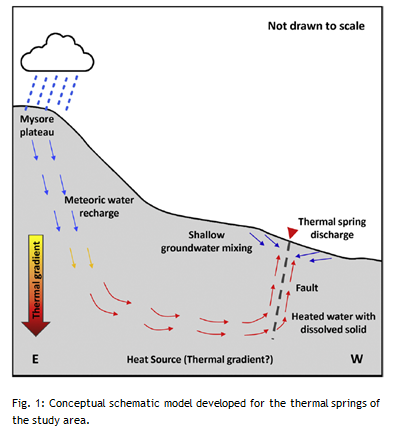 The west coast of India is one of the important geothermal provinces that hosts many thermal springs of varying discharge characteristics. A total of twenty thermal springs have been reported in this region falling into two different suites of geological formations. Two low temperature geothermal springs located in the south Konkan region were studied with the objectives (1) to understand the geochemical evolution, (2) to identify the recharge source and (3) to propose a reservoir temperature. The hydrogeological and geochemical investigations were carried out on two geothermal springs, viz. Bandaru and Irde, both located in the Dakshina Kannada district of the Karnataka state, India. In this region, low-temperature geothermal activity has been reported in the form of the evolution of warm water from thermal spring systems with a notable presence of faults/lineaments in the geological formation. These faults enable the upward flow of geothermally heated water. The hydrochemistry of water samples was analyzed to determine the dominant hydrogeochemical processes in the region. These thermal springs are categorised as Na-HCO3 type facies. The thermal water is of a moderately alkaline nature like other geothermal springs of the west coast of India. Based on the results for major and trace element concentrations it was found that the hydrochemical process was mainly controlled by the dissolution of silicate minerals with a marginal influence from anthropogenic activity. Evaluation of δD and δ18O stable isotope data suggested that the thermal springs and adjacent surface and groundwater were of meteoric origin. Reservoir temperature was estimated with Na-K-Ca, K2/Mg, quartz and chalcedony geothermometers. The results suggest that the reservoir under consideration is a low enthalpy reservoir with temperatures ranging between 55 and 86 °C.
The west coast of India is one of the important geothermal provinces that hosts many thermal springs of varying discharge characteristics. A total of twenty thermal springs have been reported in this region falling into two different suites of geological formations. Two low temperature geothermal springs located in the south Konkan region were studied with the objectives (1) to understand the geochemical evolution, (2) to identify the recharge source and (3) to propose a reservoir temperature. The hydrogeological and geochemical investigations were carried out on two geothermal springs, viz. Bandaru and Irde, both located in the Dakshina Kannada district of the Karnataka state, India. In this region, low-temperature geothermal activity has been reported in the form of the evolution of warm water from thermal spring systems with a notable presence of faults/lineaments in the geological formation. These faults enable the upward flow of geothermally heated water. The hydrochemistry of water samples was analyzed to determine the dominant hydrogeochemical processes in the region. These thermal springs are categorised as Na-HCO3 type facies. The thermal water is of a moderately alkaline nature like other geothermal springs of the west coast of India. Based on the results for major and trace element concentrations it was found that the hydrochemical process was mainly controlled by the dissolution of silicate minerals with a marginal influence from anthropogenic activity. Evaluation of δD and δ18O stable isotope data suggested that the thermal springs and adjacent surface and groundwater were of meteoric origin. Reservoir temperature was estimated with Na-K-Ca, K2/Mg, quartz and chalcedony geothermometers. The results suggest that the reservoir under consideration is a low enthalpy reservoir with temperatures ranging between 55 and 86 °C.
Bibliographic Info: Prasenjit Das, Maya, K., Padmalal, D. [2020]. Hydrochemistry, geothermometry and origin of the low temperature thermal springs of South Konkan region, India. Geothermics, Vol. 90, Art. 101997. https://doi.org/10.1016/j.geothermics.2020.101997




 RTI Act
RTI Act
